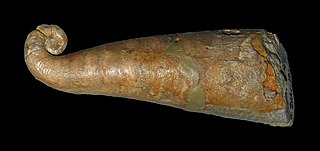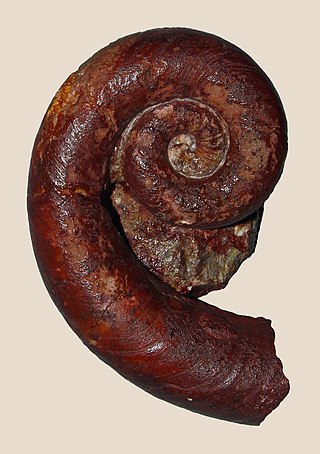Curtoceras is a genus in the tarphycerid family Trocholitidae found widespread in the late Early and Middle Ordovician of North America and northern Europe. Curtoceras has a shell that is gradually expanded, with half the fully mature body chamber divergent from the preceding volution. Whorl sections are near equidimentional with the inner margin (dosum) moderately impressed. The surface may be smooth or weakly ribbed. The siphuncle is ventral in the initial chamber and becomes dorsal after one volution. With the exception of the dorsal siphuncle, Curtoceras is somewhat similar to the tarphyceratid Campbelloceras
The Tarphyceratidae are tightly coiled, evolute Tarphycerida with ventral siphuncles. The dorsum is characteristically impressed where the whorl presses against the venter of the previous. The Tarphyceratidae are derived from Bassleroceras or possibly from some member of the Estonioceratidae.

The Trocholitidae are Tarphycerida with whorls in close contact as with the Tarphyceratidae, but in which the siphuncle, similar in structure, becomes dorsal. The Trocholitidae are derived from the Tarphyceratidae, perhaps from different tarphyceratids.

Titanoceras is an extinct genus in the nautiloid order Nautilida from the Pennsylvanian and Lower Permian of North America and Western Australia.
Basslerocerida is an order of nautiloid cephalopods from the Ordovician comprising exogastric longiconic cyrtocones, that is no longer in common use.

Orthoceratoidea is a major subclass of nautiloid cephalopods. Members of this subclass usually have orthoconic (straight) to slightly cyrtoconic (curved) shells, and central to subcentral siphuncles which may bear internal deposits. Orthoceratoids are also characterized by dorsomyarian muscle scars, extensive cameral deposits, and calciosiphonate connecting rings with a porous and calcitic inner layer.
The Tripteroceratidae is a family of depressed, straight to slightly curved nautiloid cephalopods from the middle and upper Ordovician with generally flattened venters and empty siphuncles with straight to inflated segments included in the Oncocerida.
Syringonautilidae is a family of Nautiloidea from the middle to late Triassic. Syringonautilidae comprise the last of the Trigonoceratoidea and are the source for the Nautilaceae which continued the Nautiloidea through the Mesozoic and into the Cenozoic right down to the recent. Syringonautilidae is a strictly Triassic family, derived early in the Triassic from the Grypoceratidae.

Grypoceratidae is the longest-lived family of the Trigonoceratoidea, or of the near equivalent Centroceratina; members of the Nautilida from the Upper Paleozoic and Triassic.
The Centroceratidae is the ancestral family of the Trigonoceratoidea and of the equivalent Centroceratina; extinct shelled cephalopods belonging to the order Nautilida

Ancistroceras is one of the two ancestral lituitids from the late Early Ordovician (Arenigian). The other being Holmiceras.
Holmiceras is one of two ancestral lituitids from the late Early Ordovician (Arenigian). The other being Ancistroceras.
Angelinoceras is a genus of lituitids from the Middle Ordovician that starts off with an open spiral of about 1.5 strongly compressed whorls followed by a straight orthoconic section that continues to expand for a length about equal to the diameter of the coiled portion before retaining a more or less consistent diameter. The juvenile spiral portion has a deep indentation on the ventral side of the aperture for the water-jet funnel, known as a hyponomic sinus, that becomes broad and shallow in the straight-shelled adult portion.
Rhynchorthoceras is a Middle Ordovician genus characterized by a rapidly expanded, weakly annulate orthocone, like the orthoconic section of Ancistroceras, but with only a curved, cyrtoconic apex instead of juvenile whorls.

The Estonioceratidae are a family of loosely coiled tarphycerids in which the inner side of the whorls, which forms the dorsum, is rounded or flat with no impression, and in which the siphuncle, composed of thick tubular segments, is located ventrally. The Estonioceratidae seem to form a link between the ancestral Bassleroceratidae and the more tightly coiled Tarphyceratidae.
The Rhiphaeoceratidae are a small family of nautilids included in the superfamily Tainoceratoidea that comprises four very similar genera. These genera are characterized by a perforate umbilicus and little more than a single evolute coil. Whorl sections are oval, subquadrate, or subtrapezoidal. Sutures bend forward on the outer rim, forming wide shallow ventral saddles and dip strongly to the rear on the inner rim, forming deep dorsal lobes.
Lophoceras is a genus of Nautilids belonging to the tainoceratoidean family, Koninckioceratidae, found in Lower Carboniferous sediments in Europe, and named by Hyatt, 1893. The shell of Lophoceras is evolute, large, with a slight impressed zone on the inner rim. In early volutions whorl sections are rounded, but later develop an obtusely angular ventral area and venter that disappears toward the front of the mature body chamber. The suture has an angular ventral saddle, broad shallow lateral lobe, and a dorsal lobe. Except for growth line, the shell is smooth.
The Apsidoceratidae is a family of Middle and Upper Ordovician Barrandeocerina,, characterized by curved or coiled, smooth, transversely marked, or laterally costate shells, with a conspicuous hyponomic sinus. Early whorl sections tend to be subtriangular; become broader and dorsally impressed in closely coiled forms. Sutures are with lateral lobes in primitive forms but are without lateral lobes, but with ventral lobes in more advanced species with broader sections. Siphuncles are between the center and ventral margin, but not close to either.
Plectoceras is a genus of nautiloids included in the tarphycerid suborder Barrandeocerina that lived during the Middle and Late Ordovician. It has been found widespread in the Middle and Upper Ordovician of North America.
Homoadelphoceras is a genus of gyroconic rutoceratid Nautiloid from the Middle Devonian of central Europe. Whorls not in contact, venter and dorsum,, broadly rounded. Dorso-lateral and ventro-lateral flanks more or less flat, meet at an angle.






